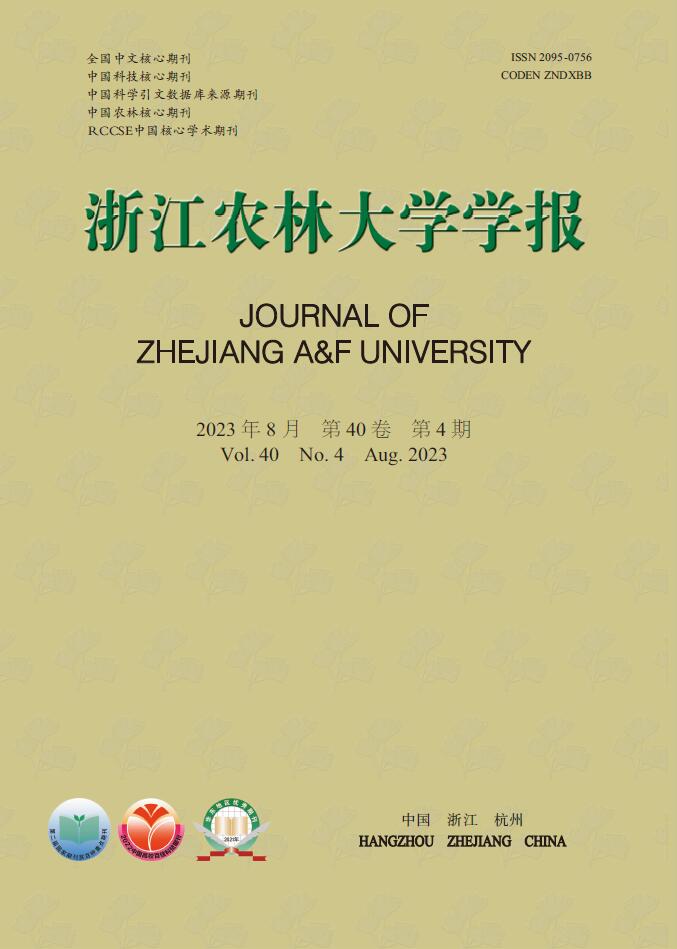-
萤火虫(鞘翅目Coleoptera:萤科Lampyridae)具有生物发光的特性,一直受到人们的喜爱和追捧[1−2]。但近几十年来,城市扩张、工业污染和土地利用的改变导致萤火虫自然生境破碎丧失,中国绝大多数地方的萤火虫种群数量已经明显减少[3−4]。从生物保护实践的角度来看,拯救受威胁物种的最佳方法就是保护其生境[5]。大多数品种的萤火虫在整个生命周期中需要利用河流、驳岸、灌木丛等多样生境空间,对小尺度、低程度的生境变化更加敏感[6−7]。因此,为了有效地保护萤火虫种群,避免人类活动的不利干扰,准确了解萤火虫的生境需求和栖息地特征是必不可少的。如日本从1996年开始对其特有的源氏萤Luciola cruciata和平家萤Aquatica lateralis的生境特征进行了长期的研究,从多角度分析了这2种萤火虫的生态习性和生境特征,为后来日本萤火虫种群繁育保护和栖息地构建提供了科学指导,一定程度上促进了当地萤火虫产业的繁荣发展[8−10]。除此之外,东南亚和美洲的许多国家也都积累了丰富的研究成果,逐渐成为全球主要的赏萤生态旅游目的地[11]。
据统计,中国已经确定的萤科昆虫有5亚科24属141种1亚种,凹眼萤科Rhagophthalmidae昆虫1属20种[7, 12]。随着自然保护意识的增强和生态旅游的兴起,某些品种的萤火虫逐渐被大家所熟知。这其中就包括峨眉萤属Emeia的三叶虫萤Emeia pseudosauteri [13]。三叶虫萤主要分布于四川、湖北和浙江。浙江省丽水市九龙国家湿地公园经过多年的生态保护建设,为三叶虫萤创造了适宜的生存环境,使得该种群通过自然累积在2014年前后大规模爆发,并且在随后的几年之中迅速扩大。根据九龙国家湿地公园管理处的统计,高峰期三叶虫萤种群数量可达4 000多万只,在湿地公园内80%的地方均有出现。三叶虫萤的虫卵、幼虫和成虫都需要稳定高质量的栖息地环境,对环境变化和人类活动干扰有着强烈的敏感性[13],可以作为非常优秀的环境指示物种。除此之外,三叶虫萤所需要的生境条件能够涵盖其他类似物种的生境需求,并在典型环境中填补掠食者生态位,可以作为伞护种维持生态系统的平衡和稳定[14−15]。更重要的是,三叶虫萤羽化成虫时间在每年的3—4月,相较于其他品种萤火虫更早,延长了国内以往只在6—8月的赏萤时间,而且种群密度高,极易形成大面积的萤火虫闪光美景[13]。这些优点使得三叶虫萤在短短几年之内就成为丽水生态旅游、文化宣传、自然教育、环境保护等活动的理想主角,唤起公众对于生态环境的保护意识[16−18]。因此,作为极具价值的昆虫资源,三叶虫萤的保护利用研究需要得到充分重视。目前三叶虫萤相关研究集中在生物形态、生殖生理、虫卵孵化、幼虫发育等方面[13, 19−20],缺少关于生境需求和栖息地环境因子等方面的研究。鉴于此,本研究选取了多个环境因子数据,分析九龙国家湿地公园内三叶虫萤现有分布区的生境特征,了解三叶虫萤生境需求,研究生境因子对三叶虫萤种群密度的影响,以期为三叶虫萤物种资源的保护利用、种群繁育、栖息地保护管理等提供科学参考。
-
从2015年开始,持续调查记录三叶虫萤栖息地范围的变化情况。截至2022年4月,三叶虫萤的分布区域可以分为一大一小2个区块,分别为九龙国家湿地公园区块和2022年新增加的白岩绿道区块,整体呈现出以九龙国家湿地公园为中心沿着大溪流域向上下游扩散的趋势。根据三叶虫萤栖息地分布情况,结合植被、地形等特征,以间隔最少200 m为限制条件,在研究区内设置了34个调查点。
-
三叶虫萤飞行移动性较低且发光时长和闪烁间隔明显,因此采用目视观察法和闪光计数法记录单位面积内三叶虫萤成虫数量,以此来计算调查点的三叶虫萤种群密度[9, 13]。由往年数据统计可知:三叶虫萤成虫数量一般在每年的4月初达到峰值,在日落1 h后出现发光的鼎盛期。由于调查点数量较多,因此将三叶虫萤种群密度调研设定在2022年4月1—10日20:00—21:00分多次进行。根据三叶虫萤活动情况,在每个调查点中挑选目测发光点较为集中的区域随机设置2~3个1 m×1 m的正方形样方,每个样方由2~3名观测员同时观测记录三叶虫萤的数量,观测时间持续1 min,以所有观测员所计数值的平均数作为该样方的种群数量[8]。为了避免重复计数和减少误差,规定观察到同一点连续发光闪烁2次以上记为1只。同样为了避免观测员目视疲劳所导致的计数误差,会进行人员轮换,以此来提升观察数据的客观性和可靠性。最后以所有样方的平均数作为该调查点的三叶虫萤种群密度。
-
在充分考虑三叶虫萤习性和研究区域内生态环境特征的前提下,本研究选择了气候因子(气温、相对湿度、风速),光照因子(环境光),植被因子(郁闭度、乔木平均高度、植被密度、灌木地被平均高度、地被覆盖度、凋落物层厚度),土壤因子(土壤pH值、土壤含水量)作为影响三叶虫萤种群密度的生境因子。为了确保生境因子的时效性,每个调查点关于气温、相对湿度、风速、环境光强的测量以及土壤取样工作与该点种群密度调研在同一时段进行。植被因子的调查于2022年4月上旬完成。在每个调查点中选择三叶虫萤较为集中的区域,设置5 m×5 m的正方形生境因子调查样方。具体调查测量方法如下。
气温和相对湿度:利用德力西THM-01便携式温湿度计测量,重复3次,取平均值。风速:利用标智GM8902手持式风速仪测量,重复3次,取平均值。环境光强:使用分辨率为0.01 lx的泰仕TES-1330A数字照度计,依次测量样方左右前后上共5个方向的环境光强,取平均值。郁闭度:采用树冠投影法测量[23]。乔木平均高度:测量记录样方内所有乔木的高度,取平均值。植被密度:在5 m×5 m的样方内随机设置1个1 m×1 m的小样方,测量计算小样方内地被和小灌木数量获得。灌木地被平均高度:测量样方对角线上所有灌木和地被层植株的高度,取平均值。地被覆盖度:在5 m×5 m的样方内随机设置1个1 m×1 m的小样方,并在方格纸中绘制出小样方内地被和小灌木所占范围,估算其占小样方比例,作为该调查点地被覆盖度。凋落物层厚度:在样方中随机选取5个点,测量凋落物层厚度,取平均值。土壤pH:在5 m×5 m的样方内采用梅花形5点取样法进行采土,每个点取土深度为20 cm,采土200~250 g,将同一个样方中5个点的土壤均匀混合,得到1 000~1 250 g土壤样本并标号,将土壤样本带回实验室检测土壤pH。土壤含水量:利用采集到的土壤样本检测土壤含水量。
-
利用Shapiro-Wilk检验确定种群密度和生境因子数据是否符合正态分布,对于非正态分布的变量数据进行对数转换[24]。为了排除数据量纲不同而造成的偏差,将所有比例数据进行反正弦转换[25]。利用Pearson相关性分析法,剔除高相关性变量,排除变量之间多重共线性对分析结果的影响,再将筛选出的生境因子作为自变量,种群密度作为因变量纳入多元逐步回归分析中。为了确保逐步回归模型中只包含显著相关的关键因子,所有生境因子都要根据F检验来决定输入或者剔除[26]。由此筛选出影响三叶虫萤种群密度的关键生境因子,并建立包含关键因子的逐步回归方程。以上分析均在SPSS 26.0中进行。
-
各调查点三叶虫萤种群密度和生境因子如表1所示。
点位编号 D/(只·m−2) XTEMP/℃ XRH/% XWS/(m·s−1) XAL/lx XCC/% XATH/m XPD/(株·m−2) XAHSG/cm XGC/% XTBL/cm pH XSWC/% 1 4.3 12.4 63.80 1.4 0.07 63 15.8 78 16.7 63.50 6.3 6.24 33.32 2 8.2 11.3 77.30 0.7 0.05 86 12.5 105 18.5 72.40 11.5 5.85 47.16 3 2.1 11.6 59.27 1.8 0.17 57 16.5 69 16.3 60.50 4.3 5.92 33.47 3 0.2 13.3 52.48 2.7 0.25 37 4.5 38 82.5 52.40 3.4 6.84 34.64 5 0.7 10.8 54.23 2.3 0.20 42 8.6 66 68.4 66.20 2.8 6.58 32.53 6 0.2 10.3 56.04 3.0 0.22 24 3.8 53 22.5 43.60 1.9 6.13 38.61 7 4.8 9.7 67.16 1.5 0.11 68 9.5 82 32.6 84.60 6.6 6.74 42.12 8 6.4 10.4 66.70 1.5 0.09 86 14.0 99 32.3 87.30 6.5 6.38 42.64 9 0.8 10.9 64.30 2.2 0.16 53 9.8 59 58.7 58.32 4.5 6.11 37.68 10 0.3 11.7 58.64 2.1 0.19 32 6.8 47 72.4 47.93 1.8 5.83 41.28 11 1.8 11.3 57.12 2.2 0.13 61 5.3 63 62.4 78.30 6.2 6.38 35.26 12 5.2 9.8 74.24 1.3 0.06 75 9.5 86 44.6 83.70 5.7 6.44 43.62 13 1.3 12.4 68.59 1.9 0.14 44 10.5 64 67.3 90.20 4.7 6.81 37.66 14 4.4 11.8 70.43 1.9 0.08 72 17.5 87 37.4 96.50 3.7 5.66 36.46 15 7.1 10.8 69.20 1.2 0.06 77 15.4 95 68.3 95.40 10.3 6.59 43.87 16 10.2 11.2 76.53 0.6 0.03 94 17.3 108 46.5 92.30 9.6 6.56 45.26 17 9.4 11.6 75.32 0.3 0.02 90 5.5 103 37.5 79.20 8.4 6.37 40.68 18 0.4 10.3 55.71 2.5 0.15 47 15.0 56 77.5 94.40 3.3 6.28 32.52 19 0.6 12.3 62.21 1.8 0.17 35 4.5 62 17.5 83.50 4.4 5.71 31.38 20 4.6 10.5 71.43 0.9 0.04 73 9.8 77 33.5 93.80 8.2 6.25 36.59 21 3.8 10.7 67.23 2.2 0.09 71 11.5 70 33.5 72.60 5.2 6.55 38.21 22 4.5 11.5 64.54 1.6 0.06 82 12.3 84 47.3 82.40 5.5 6.62 41.64 23 6.2 9.6 71.58 1.2 0.05 79 9.7 95 47.4 81.64 7.8 5.97 40.83 24 1.4 10.3 66.53 2.6 0.12 68 8.6 67 22.8 78.79 5.3 6.45 35.77 25 2.7 9.4 65.28 1.4 0.10 53 5.7 72 73.6 72.51 5.2 6.33 43.62 26 3.2 11.5 70.52 1.7 0.09 56 7.5 77 55.5 57.38 3.8 6.57 44.69 27 0.2 12.7 63.88 2.6 0.28 44 8.5 35 87.2 44.52 2.3 5.93 32.17 28 7.6 11.4 67.28 0.5 0.07 74 12.5 92 45.7 88.62 6.5 6.43 44.86 29 6.5 10.8 70.35 0.9 0.10 73 11.6 94 44.9 74.68 9.4 6.58 39.82 30 8.4 9.7 73.22 0.4 0.08 83 14.2 104 34.8 85.46 11.2 5.74 43.74 31 3.6 10.6 71.83 2.5 0.12 64 7.8 76 52.7 76.51 6.8 5.69 36.53 32 7.3 11.5 73.24 0.7 0.04 92 9.3 99 33.2 92.66 7.9 5.82 42.65 33 6.8 10.3 75.62 0.5 0.03 66 10.8 97 27.5 85.92 8.5 6.33 43.72 34 5.7 9.8 72.57 0.8 0.09 70 9.2 83 31.7 86.52 4.8 6.41 39.64 说明:D. 三叶虫萤种群密度;XAL. 环境光强;XPD. 植被密度;XTEMP. 气温;XRH. 相对湿度;XWS. 风速;XCC. 郁闭度;XATH. 乔木平均高度;XAHSG. 灌木地被平均高度;XGC. 地被覆盖度;XTBL. 凋落物层厚度;pH. 土壤pH;XSWC. 土壤含水量。 Table 1. Results of E. pseudosauteri population density and habitat factors in 34 survey sites
-
如果相关系数|r|≥0.8,则认为2个变量之间存在高度相关性,需要剔除[27]。从表2可见:环境光强和植被密度与其他生境因子普遍存在高度相关性,因此剔除这2个因子。最终筛选出气温、相对湿度、风速、郁闭度、乔木平均高度、灌木地被平均高度、地被覆盖度、枯枝落叶层厚度、土壤pH、土壤含水量等10个生境因子变量用于回归分析。
生境因子 XTEMP XRH XWS XAL XCC XATH XPD XAHSG XGC XTBL pH XSWC XTEMP 1 XRH −0.295 1 XWS 0.235 −0.756 1 XAL 0.247 −0.801 0.826 1 XCC −0.264 0.764 −0.742 −0.834 1 XATH −0.040 0.289 −0.329 −0.313 0.489 1 XPD −0.381 0.801 −0.852 −0.851 0.884 0.477 1 XAHSG 0.193 −0.379 0.367 0.389 −0.363 −0.214 −0.483 1 XGC −0.291 0.492 −0.512 −0.581 0.594 0.476 0.611 −0.174 1 XTBL −0.287 0.727 −0.776 −0.739 0.788 0.367 0.833 −0.344 0.508 1 XSPH −0.021 −0.119 0.004 −0.048 0.017 −0.050 −0.021 0.264 0.069 −0.018 1 XSWC −0.394 0.654 −0.656 −0.611 0.588 0.153 0.696 −0.132 0.255 0.577 0.141 1 说明:D. 三叶虫萤种群密度;XAL. 环境光强;XPD. 植被密度;XTEMP. 气温;XRH. 相对湿度;XWS. 风速;XCC. 郁闭度;XATH. 乔木平均高度;XAHSG. 灌木地被平均高度;XGC. 地被覆盖度;XTBL. 凋落物层厚度;pH. 土壤pH;XSWC. 土壤含水量。 Table 2. Results of correlation analysis of 12 habitat factors in E. pseudosauteri habitat
-
由表3可知:多元逐步回归分析模型的相关系数(R)、决定系数(R2)、调整后的决定系数($R_{{\rm{adj}}}^2 $)均大于0.8,说明模型拟合度高,所建立的回归方程可以很好地反映种群密度与生境因子之间的关系。在显著水平下(P<0.05)模型最终包含了郁闭度、风速和土壤含水量这3个生境因子变量,R2 adj为0.930,说明这3个生境因子是影响三叶虫萤种群密度的关键因子。Durbin-Watson检验统计量为1.615,接近于2,证明被选择的3个生境因子变量之间相互独立,没有自相关性[28]。
生境因子 R R2 $\scriptstyle R_{{\rm{adj}}}^2 $ ESE d 郁闭度 0.903 0.816 0.810 1.304 3 风速 0.962 0.925 0.921 0.843 1 土壤含水量 0.968 0.937 0.930 0.790 3 1.615 说明:R为相关系数;R2为决定系数;$\scriptstyle R_{{\rm{adj}}}^2 $为调整后的决定系数;d为Durbin-Watson检验统计量;ESE为估计标准误差。 Table 3. Results of stepwise regression analysis of E. pseudosauteri population density and habitat factors
由表4可知:在回归分析中,被纳入的3个生境因子变量方差膨胀系数为1.830~2.665,均小于5,说明变量之间不存在多重共线性,符合多元回归分析的要求。3个生境因子变量t检验对应的P均小于0.05,说明郁闭度(P<0.001)、风速(P<0.001)和土壤含水量(P=0.029)对种群密度存在显著影响。标准化系数(β)可以反映自变量对因变量影响的重要程度,其绝对值越大则对因变量的影响越大,而其正负性可以表示自变量与因变量之间是正相关或负相关。因此,对三叶虫萤种群密度影响最大的是郁闭度(β=0.505),其次是风速(β =−0.424)和土壤含水量(β = 0.143)。其中郁闭度和土壤含水量与种群密度呈正相关,说明郁闭度和土壤含水量较高的地方更适合三叶虫萤生存栖息。风速与种群密度呈负相关,风速越大,种群密度越小。最终可以建立郁闭度(XCC)、风速(XWS)、土壤含水量(XSWC)对三叶虫萤种群密度(D)的逐步回归方程:D=7.446XCC−1.666XWS+9.337XSWC−6.584。
被选择的变量 未标准化系数(B) 标准误差 标准化系数(β) t P 共线性统计 容差 方差膨胀系数 常数项 −6.584 3.038 −2.168 0.038 郁闭度 7.446 1.033 0.505 7.209 0.000 0.431 2.318 风速 −1.666 0.295 −0.424 −5.650 0.000 0.375 2.665 土壤含水量 9.337 4.062 0.143 2.299 0.029 0.546 1.830 Table 4. Stepwise regression model coefficients of E. pseudosauteri population density and habitat factors
-
适宜的生境能够为三叶虫萤提供生存资源、空间庇护和繁衍条件。一些生境因子对三叶虫萤种群密度的影响本质上就是三叶虫萤根据自身的生物特性和生活习性对自然环境所做出的一种选择。结合三叶虫萤的生物特征和生活习性能够尝试解释这些因子发挥作用的原因。
萤火虫会在夜晚发出特殊的生物闪光,这些闪光信号拥有通信交流、吸引求偶、警示天敌、引诱捕食等功能,并且可能存在完善的闪光通信系统[29]。萤火虫为提升闪光通信功能的利用效果,需要较为黑暗的空间,即使月光也会阻碍其活动。研究证明:郁闭度能够影响栖息地的光环境,从而对萤火虫成虫种群密度产生影响[30]。在本研究中,生境因子郁闭度(β=0.505,P<0.001)是影响三叶虫萤种群密度的主要原因,较高的郁闭度可以遮蔽月光和人造光,为三叶虫萤创造适宜的夜晚活动空间。在未来的栖息地保护管理中需要重点关注九龙国家湿地公园及其周边区域的植被茂密和覆盖情况,避免由于水流冲击、人为破坏、农田耕作等因素,导致植被减少,郁闭度下降。
一定程度的风速会对飞行昆虫的活动产生影响[31]。逐步回归分析结果表明:三叶虫萤种群密度会随着风速(β=−0.424,P<0.001)增大而降低,整体呈现负相关。作为小型飞行昆虫的三叶虫萤会因为较大的风速而无法进行正常的飞行活动。在实地调研中发现:三叶虫萤雄萤飞行能力远胜于雌萤。雄萤经常活动在灌木地被植物顶端,飞行高度集中在0.5~1.6 m。雄萤依靠飞行能力可以根据闪光信号轻松找到隐藏在草丛里的雌萤并完成交配。因此低风速甚至无风的区域是三叶虫萤成虫寻找配偶完成交配的最佳场所,会有大量的成虫聚集,种群密度也会相对较高。
三叶虫萤虽然是陆生萤火虫,但表现出较高的亲水性,主要的栖息地都沿着河流分布。这可能是由于三叶虫萤喜好将虫卵产在石下阴暗处和潮湿的苔藓上。有研究证明:当三叶虫萤的虫卵处于湿度为40%的孵化介质中时,最容易成功孵化[32]。由此可以推测:河流水域周围土壤含水量较高,苔藓、腐殖质、凋落物等适合产卵的介质湿度也相对较高,符合虫卵孵化条件。本研究土壤含水量(β = 0.143,P = 0.029)对三叶虫萤种群密度正相关的结果也在一定程度上支持了这一观点。土壤含水量较高的区域能够吸引更多的成虫前来聚集产卵。
在三叶虫萤生境保护管理中应特别注意郁闭度的变化,可以通过增加植被密度来提高郁闭度,为三叶虫萤夜晚活动创造更好的条件。在每年3—5月需重点观察三叶虫萤栖息空间的风速、风向变化,并在合适的区域补植一些植被,降低风速的影响。此外,应该在三叶虫萤产卵和虫卵孵化的特殊时期,密切监测土壤和空气湿度的变化,在必要的时候也可以人为增加湿度,维持合适的环境条件。
Effects of habitat characteristics on population density of Emeia pseudosauteri in Kowloon National Wetland Park, Lishui
doi: 10.11833/j.issn.2095-0756.20220616
- Received Date: 2022-09-26
- Accepted Date: 2023-01-15
- Rev Recd Date: 2023-01-08
- Available Online: 2023-07-13
- Publish Date: 2023-08-20
-
Key words:
- Emeia pseudosauteri /
- population density /
- habitat factors /
- multiple stepwise regression analysis /
- Kowloon National Wetland Park
Abstract:
| Citation: | WANG Zesheng, LI Sheng, TAO Yizhou, et al. Effects of habitat characteristics on population density of Emeia pseudosauteri in Kowloon National Wetland Park, Lishui[J]. Journal of Zhejiang A&F University, 2023, 40(4): 859-866. DOI: 10.11833/j.issn.2095-0756.20220616 |









 DownLoad:
DownLoad: